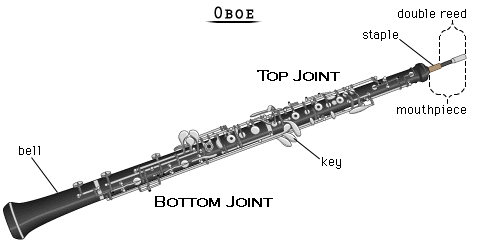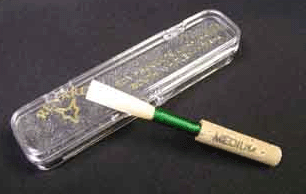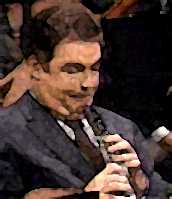 The oboe
The oboeThe oboe Dimensions:
Length (including reed and staple): 25 1/2 inches
Length of reed and staple protruding from instrument: 2 1/2 inches.
Width of reed: 1/2 inch.
Diameter of bore at top: 3/16 inch.
Diameter of bore at bell joint: 5/8 inch.
 The oboe
The oboe
TOP JOINT
BOTTOM JOINT
BELL
Two examples of oboe playing
The Flight of the Bumblebee. Oboist is Michael Kibbe, recorded in 1987. The oboe is the primary instrument playing the melody, although it is taken over by clarinet at some points just to give the soloist time to breathe.
Listen!
One of the greatest works for oboe of all time is the Concerto written by Richard Strauss. It was inspired by a visit that American oboist John De Lancie made to Strauss's home in Germany. He had asked Strauss if the composer had ever considered writing a concerto for oboe. He merely answered No, but the seed of inspiration was sewn and a few months later, Strauss had finished the work. Later, after De Lancie became principal of the Philadephia Orchestra, he recorded the work, and he is the oboist on the following excerpt. As oboist Allan Vogel put it, "The only problem with the Strauss Concerto is where to breathe."
Here is the Concerto's opening. Please note how LONG the phrases are, and when the oboist finally gets to pant for breath about 48 seconds into the piece, the clarinet allows little time for rest.
CHANGES IN CONSTRUCTION AFTER 1830
Although oboe-like instruments had existed for centuries, the forerunner of the modern oboe was developed by Joseph Sellner in Vienna around 1825. At this time in France, other refinements in the form of extra keys and finger plates began to be added to the instrument until by 1906, the oboe was virtually as it is today. In the early 1840s, Louis Auguste Buffet, who had earlier modified the Boehm flute, designed an oboe that used Boehm's principles. The result was a more powerful instrument that found much favor with military band musicians but little with French oboists. Another probable reason for the failure of Buffet's design was the change in fingering. Other attempts to adapt Boehm's system to the oboe have met with equal resistance.
Essentially, the air column within an oboe is a cone-shaped length with the tip removed and replaced by the reed. The unique timbre of the oboe is a function of the conical bore of the instrument as well as the position and size of the holes drilled along the length of the instrument.
Once the column of air is set in motion, the pitch is adjusted by shortening and lengthening the column by opening and closing holes and keys, a method identical to the flute.
Proper intonation on the oboe can be controlled by air pressure and by lip pressure upon the reeds.
A boxen hautboy, loud and sweet of sound,
(Ambrose Philips, "Pastorals," 1709)
"Oboe" is derived from the french name for the shawm, Hautbois, or "loud woodwind."
"The oboe is rather limited in agility, in contrast to the lambent flute or the peripatetic clarinet. It compensates for these real or imaginary deficiencies, however, by the precision of its intonation and by the strength of its sound. Indeed, it can pierce through the entire orchestral fabric as easily as the trumpet."
Slonimsky, Nicolas, Lectionary of Music, Mc Graw Hill, New York, 1989.
"Purely as a stunt, some oboe-players, past and present, have acquired the faculty of taking breath as glass-blowers and Oriental reed-instrument players do, namely through the nose when
"circular breathing." For this, enough air is held in the cheeks to supply the reed (by tightening the cheeks) during the instant (o breathing through the nose. It is said that Reynolds, an oboist with the Halle Orchestra many years ago, used to play the entire English horn solo on the stage in the last act of Tristan in this way .... "
Baines, Anthony, Woodwind Instruments and their History, w.w. Norton & Co., New York, 1962.
Suggested works for further listening
BELLINI: Concerto for Oboe and Orchestra
BRITTEN: Six Metamorphoses for Oboe
MARCELLO, A.: Concerto in C minor for Oboe and Strings
MOZART: Concerto in C, K. 314
ROSSINI: Overture to "The Italian Girl in Algiers"
SCHUMANN: Three Romances, Op. 94
STRAUSS, R: Concerto for Oboe and Small Orchestra
VAUGHAN WILLIAMS: Concerto for Oboe and Small Orchestra
 Staple and reed (what all great oboists become masters of)
Staple and reed (what all great oboists become masters of)
Grenadilla, rosewood, cocus, or ebonite;
Holds staple with reed and contains keys for left hand
Grenadilla, rosewood, cocus, or ebonite;
Contains keys for right hand and thumb-rest
Grenadilla, rosewood, cocus, or ebonite;
Adds appropriate length to air column to compensate for length lost due to conical bore of air column. Harold Gomberg, former principal oboist of the NY Philharmonic
Harold Gomberg, former principal oboist of the NY Philharmonic
All varnished and with brazen ringlets round,
I to the victor give.